 During the course of the war the flow of casualties from the various theatres of war overwhelmed the existing Medical facilities in the United Kingdom just as it did in the established bases in France and Flanders, many buildings were turned over to Military use. Large numbers of public and private houses, some larger houses were used as small Hospitals and operated as annexes to nearby Hospitals. These Auxiliary Hospitals attached to the larger Hospitals looked after patients who still remained under military control, in all there were over 3000 Auxiliary Hospitals and were administered by Red Cross County Directors. They were usually staffed by a Commandant who was in charge of the Hospital (excepting medical and nursing services,) a Quartermaster, responsible for receipt and issue of articles from the stores, a Matron who directed the nursing staff and members of the local voluntary aid detachments who were trained in first aid and home nursing.
During the course of the war the flow of casualties from the various theatres of war overwhelmed the existing Medical facilities in the United Kingdom just as it did in the established bases in France and Flanders, many buildings were turned over to Military use. Large numbers of public and private houses, some larger houses were used as small Hospitals and operated as annexes to nearby Hospitals. These Auxiliary Hospitals attached to the larger Hospitals looked after patients who still remained under military control, in all there were over 3000 Auxiliary Hospitals and were administered by Red Cross County Directors. They were usually staffed by a Commandant who was in charge of the Hospital (excepting medical and nursing services,) a Quartermaster, responsible for receipt and issue of articles from the stores, a Matron who directed the nursing staff and members of the local voluntary aid detachments who were trained in first aid and home nursing.
In many cases women in the neighbourhood volunteered on a part-time basis, although they often needed to supplement voluntary work with paid labour such as in the case of cooks. Medical attendance was provided locally and voluntarily despite the extra strain that the medical profession was already under at that time.
The patients at these hospitals were generally less seriously wounded than at other hospitals and needed convalescence. The servicemen preferred the Auxiliary Hospitals to Military Hospitals because they were not so strict. Also, Auxiliary Hospitals were less crowded and the surroundings more homely.
Rossendale had two such Hospitals New Hall Hey and Pike Law both running at the same time. The buildings that formed New Hall Hey Auxiliary Hospital are long gone and were situated approximately where the large roundabout and Fire Station are in Rawtenstall centre. As we shall see subscriptions to help with the cost and running of the Hospital came from all walks of life and indeed the many businesses in the town at that time. Rossendale Free Press always on hand with a story kept readers apace with developments and indeed the wounded patients of the Hospital as time went by with functions etc. to help the wounded also included in their editions.
Below is an article that appeared in the Free Press on the 27th of March 1915.
THE MILITARY HOSPITAL AT RAWTENSTALL OPENED TO THE PUBLIC THIS AFTERNOON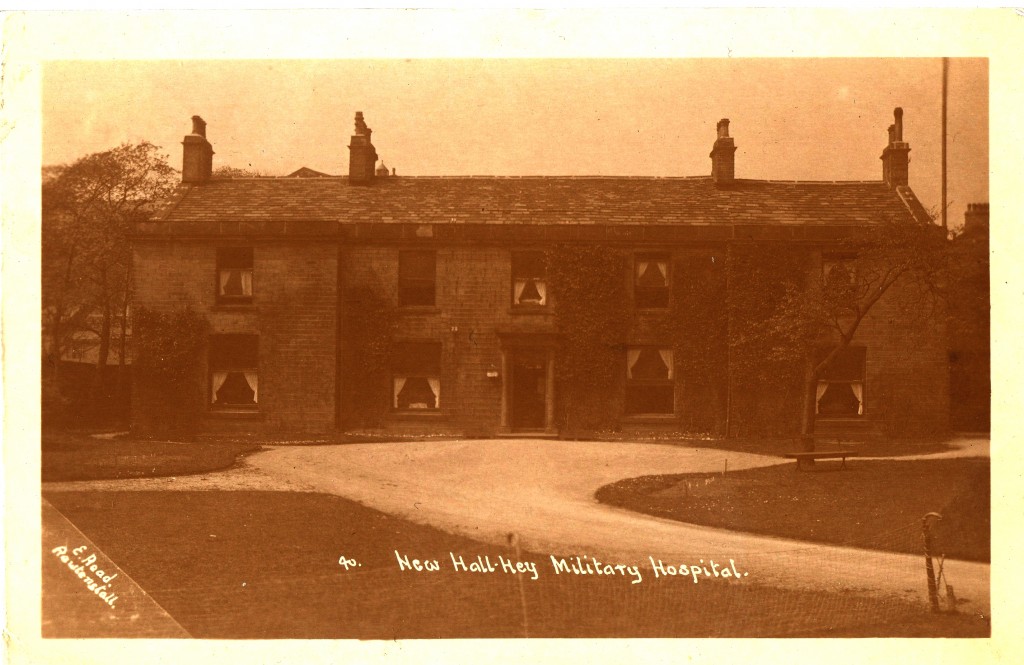
The above picture is a view of the Military Hospital Newhall Hey House, Rawtenstall, which will be open for inspection by the public from 2 to 5 o-clock this Saturday afternoon. The Committee and officials who have charge of the same have been working quietly but most energetically for some time past, and their labours have been met with much success.
The premises have been beautifully decorated and admirably arranged and twelve beds, along with other necessary equipment have been installed. The Hospital will be under the supervision of a fully qualified and trained Hospital nurse supplied by the St Johns Ambulance Brigade from the Headquarters in London, and she is expected to arrive at any time. Through the generosity of Miss Carrie Whitehead of Holly Mount, a resident cook has been appointed namely, Mrs Cartwright whose excellent services will be remembered in connection with the Central Canteen at the old Technical School. Information has been sent to the Army Authorities that the premises will be ready for the official inspection on Tuesday next, after which they will be ready for the reception of the Soldiers.
Donations in the shape of money or goods will be thankfully received at the Hospital this afternoon or at any time, and we feel certain there will be a most generous response for such a patriotic and deserving object.
Further to the above article came this breakdown of contributions and donations from individuals and groups of workers, all rallying to the cause as it were and read…..
After the disastrous Gallipoli campaign of 1915 and the Battle of the Somme that raged from July to November 1916 which incidentally on the 1st of July 1916, the British Army encountered its worst day in battle with some 50,000 casualties, approximately 20,000 dead in a single day, the existing facilities would indeed be overwhelmed.
One of the first local lads to use the services of New Hall Hey was Driver William Meeks of Crawshawbooth (excerpt Free Press Autumn 1915) who was wounded by shellfire on Gallipoli and spoke for the other soldiers in the Hospital who were all well pleased with their care.
Driver William Meeks recovered only to lose his life in a fire in Palestine 1918. William is buried at Kantara war Cemetery Egypt and commemorated locally on the Crawshawbooth War Memorial.
Due to the swelling numbers of casualties a new wing was opened in October 1916 and was duly named Kitchener Ward after the famous then Secretary of State for War who’s famous recruitment poster we see on the left. Kitchener was killed in 1916 when the warship taking him to negotiations in Russia was sunk by a German mine. After his death he was criticised and often dismissed as a great poster but not a great administrator. Nonetheless his name adorned the new wing which cost in the region of £400 adding much needed services to a burgeoning casualty list.
The Opening of the Kitchener Ward October 14th 1916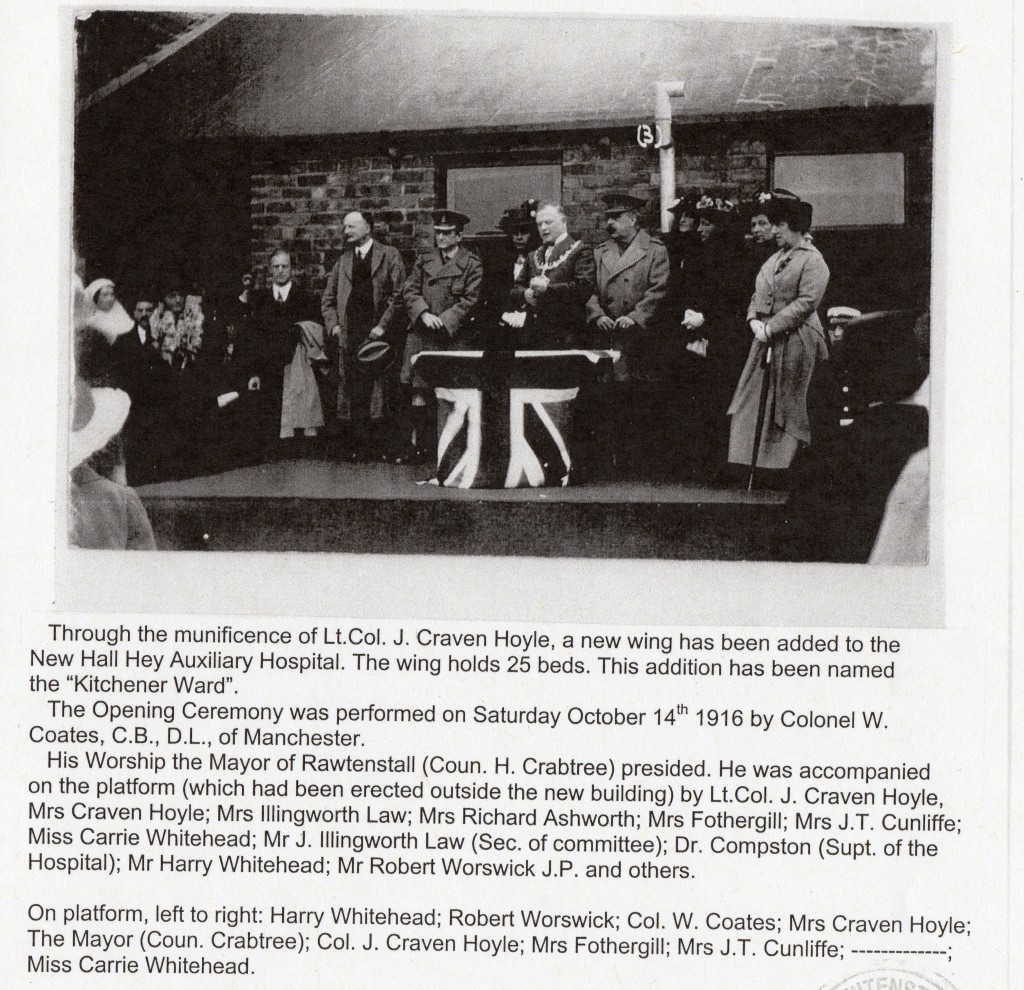 Summary of the events at the opening of the Kitchener Ward
Summary of the events at the opening of the Kitchener Ward

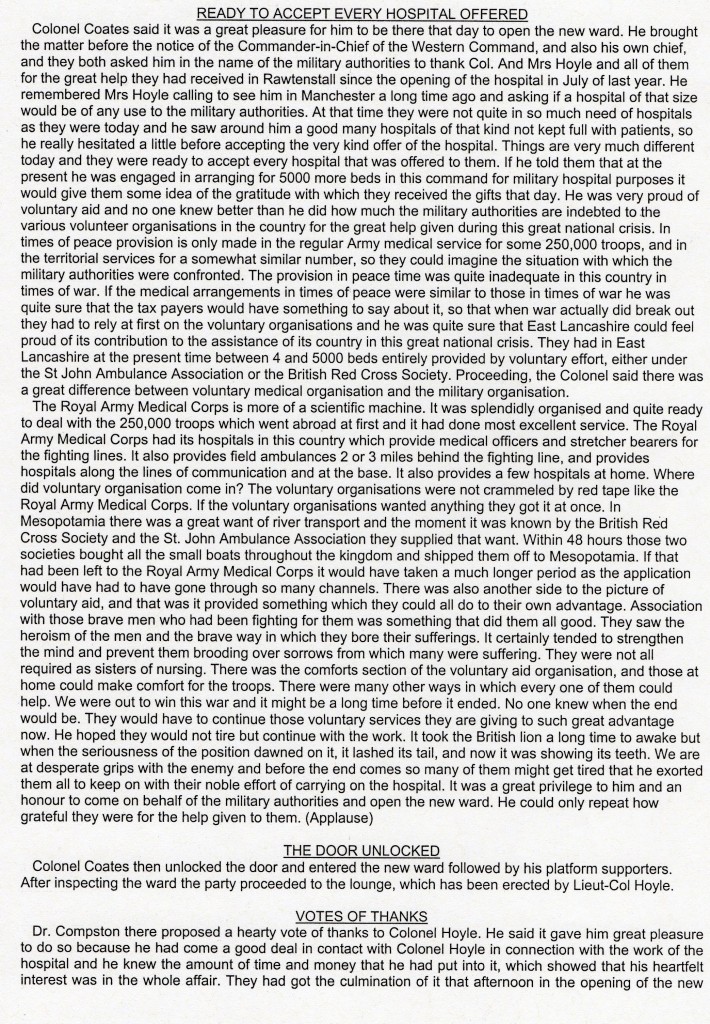
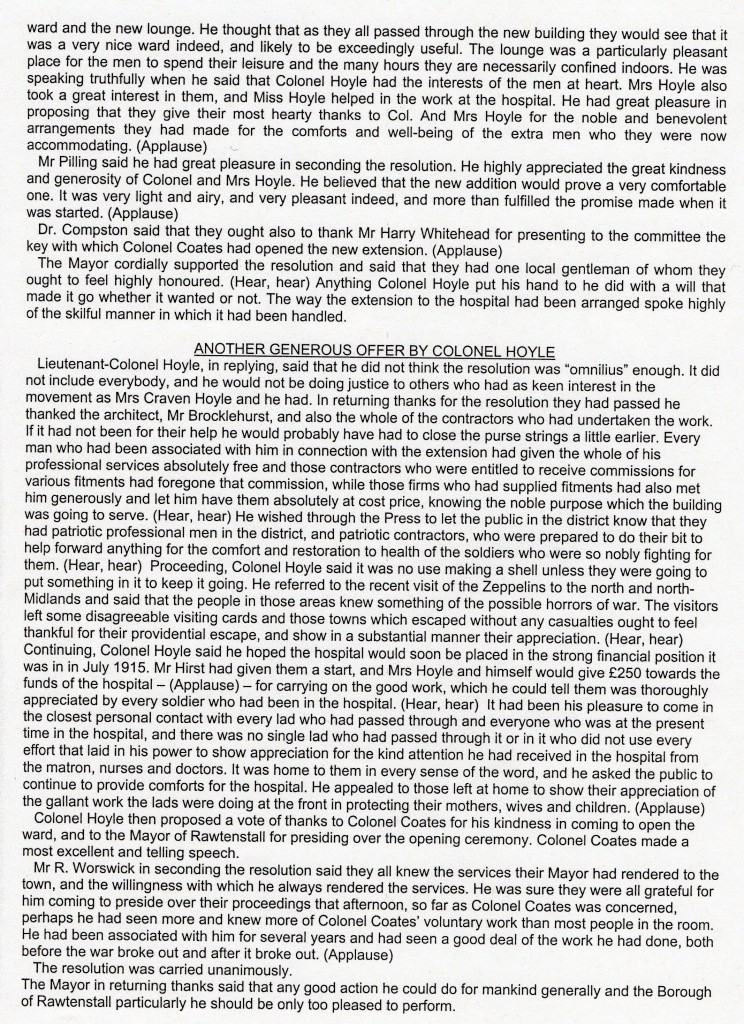

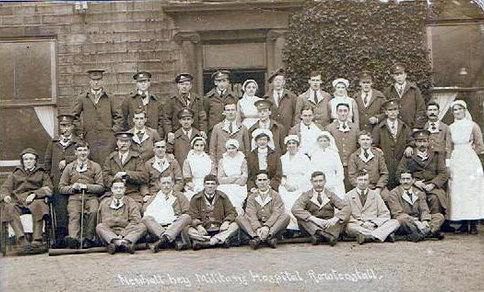
New Hall Hey Military Hospital served the needs of the wounded and sick from July 1915 past the wars end in November 1918 and into early 1919, when in March of that year, came the announcement of its closure.
NEW HALL HEY HOSPITAL CLOSING
700 Soldier Patients Have Passed Through
The New Hall Hey Auxiliary Military Hospital will definitely be closed in the course of the next week or fortnight. Since the institution was opened in July 1915, close upon 700 wounded soldiers have been dealt with therein, while the number of beds have been increased periodically from 18 at the opening to 66. The first increase comprised of four beds, and in April 1916 a similar number was added, bringing the total to 26. In October of the same year the bed accommodation was further augmented to 43, when Col. Coates opened the” Kitchener” Ward. A good number of beds have been provided by different firms in the district, the last instalment was made in April 1917 when the War Office loaned a further 18. Miss Richardson it may be remembered was the first Matron Sister at the Hospital and in January 1916 Miss Newsome succeeded her as Matron. A trained sister was appointed in August of the same year and a second sister for night duty in the following October.
All the Medical men in Rawtenstall, Crawshawbooth and Waterfoot have given their services to the Hospital; Dr E.L. Compston as senior Medical Officer, and Dr J. Paton Stuart as deputy senior. The resident staff have been augmented by members of the V.A.D, the Rawtenstall and Crawshawbooth St. Johns Ambulance Brigade, and the Waterfoot St John Ambulance Brigade (V.A.D.) The latter section which came into being in January 1917 were trained by Miss Newsome. The different sections have done duty for a week at a time and when circumstances necessitated it often for a month.
Apart from the splendid voluntary efforts from outside, some excellent concerts have been given by the patients who organised themselves into concert parties with the result that a good round sum has been obtained for the Hospital Comforts fund. Perhaps the best known of the parties were the “Ding Dongs” the majority of who were professional artistes and concerts were given in the New Palace Theatre and the King’s Hall Waterfoot. This party which included two local artistes Driver Pepper and Mr Longland were instrumental in raising about £80. Another party who styled themselves “The Mascots” gave an entertainment in the Kitchener Ward when about £20 was raised. Other concerts of an impromptu nature have been frequently given all going to show that the social life of the institution has been what one may term “Merry and Bright.”
It may be added that the nurses have given their services and several of them wear service bars which denote one, two or three years service.
All the mending has been done by the nurses on Saturday afternoons and evenings. “Really the work that has been accomplished in the institution has been marvellous” said a member of the staff to our representative, “and I cannot speak too highly of those who have in any way been associated with it.” Such good results are no doubt in a large measure due to the consummate skill of the Matron Miss Newsome. On the 29th of March 1919 Rossendale Free Press stated.
NEW HALL HEY FAREWELL
NURSES GATHERING IN THE HOSPITAL
PRESENTATION TO DR.COMPSTON AND THE MATRON
The Kitchener Ward at the New Hall Hey Hospital, Rawtenstall, in which during the progress of the war many maimed and battered soldiers have been nursed back to health and strength provided the setting for a very enjoyable re-union on Wednesday evening. As has already been stated in these columns the work of the Hospital has now been accomplished. The last of the convalescent soldiers has taken his departure and the wards are silent and empty.
It was to commemorate the closing of the Hospital that Wednesday evening’s little affair was held, when on the invitation of Dr Compston the Senior Medical Officer and Miss Newsome, the Nurse Orderlies and others met for a farewell gathering. There were present apparently 80 to 100 Nurses and Orderlies and in addition the Mayor and Mayoress Colonel Craven Hoyle, Dr. Helm, Mrs. Cunliffe (Chair) and a number of other members of the Hospital committee.
Dr. Compston presided and in an introductory address referred to the work the Hospital had been able to accomplish during the past four years and how starting with 16 beds the place grew until they had a compliment of 66 beds. Dr. Compston took the opportunity of returning thanks to all who by service and help in so many different ways had made the good work possible.
He referred to the extreme kindness of Col. and Mrs Hoyle who placed that building at the disposal of the committee and who also at their own expense built that new ward in which they were assembled that night; he thanked the Matron for her efficient service, the nurses, the public, the subscribers, the ministers, the medical men, and all who had contributed in various ways towards keeping the Hospital going so successfully. Now the time had come to close the Hospital. Many had come to look on the place with affection and they would also look back on the work they had done there with satisfaction.
The boys who had passed through the Hospital had been warm in their praise of New Hall Hey. All who had helped in the work there had the satisfaction of knowing they had served their country when their country badly needed their service. Col. Hoyle said everybody connected with the Hospital could congratulate themselves on the work the Hospital had done. There had not been a single wounded soldier who had given up his life in that Hospital and there had not been a patient who had not gone away either absolutely cured or very much better for the treatment they received there.
The Mayor paid a high tribute to the skill and services of Dr. Compston and the other Medical men who had been associated with the Hospital. He had felt proud to be Mayor of Rawtenstall whilst that Hospital had been in being and likewise he had felt proud of the way in which the Public had helped the Hospital both in service and monetary sense.
Presentations
During the evening Col. Hoyle on behalf of the Rawtenstall, Waterfoot and Crawshawbooth Nursing Divisions presented Miss Newsome a gold signet ring in appreciation of the instruction the Matron had given to those concerned.
On the 19th of April 1919, in the appointments page of The British Nursing Journal was this, under “Appointments of Matrons.”
York Tuberculosis Hospital, Fairfield House, Miss Edith Newsome has been appointed Matron. She received her training in general nursing at the Portsmouth Infirmary and in midwifery at University College Hospital, London. She has held the positions of pupil Matron at Lord Kinnaird‘s Hostel, Westbourne Park: Holiday Sister at Dudley. Union Infirmary: Charge Nurse L.C.C. Special Schools, East Dulwich, S.E. Health Visitor and Inspector of Midwives for the County of Warwick; Lecturer on Nursing, Hygiene, and Infant Care, Gloucestershire School of Domestic Science: Superintendent Nurse, Worcester Union Infirmary: and Matron of the New Hall Hey Auxiliary military Hospital, Rawtenstall. She is a certified midwife, and holds certificates in hygiene.
Quite a woman and what a CV, probably as the old Matrons were not a force to be reckoned with!!
The Photograph below shows the location of the Hospital in greater detail with the instantly recognisable St Mary’s chambers in the background. It is hard to imagine this serene scene replaced by a huge roundabout and Fire Station. A poem accompanies this picture from the time of the closure of New hall Hey and the initials E.L.C. are at the bottom of the verses. Written by a war weary individual no doubt. May I thank Rawtenstall Library once again for their assistance with this image.
Mr. Stan Winter kindly replied at the foot of this page with information on his Grandfather and Grandmother, as a result of that terrible war and his convalescence at New Hall Hey, it resulted in marriage after the war, Stan’s Grandparents story is below.
The Poem
‘Tis now a memory of the past:-
The Mansion House with a fountain pond,
And ruin like ancient Greek Fane,
Placed in it’s grounds with walls beyond,
Near Olden Hall with latticed panes.
Some Generous hearts the house had lent,
And others made it’s every space
Ready that heroes battle rent
Might find a home and healing place.
‘Tis now a memory of the past:-
The added wards the dressing room,
Where many busy hours were spent,
And all made bright and free of gloom
With atmosphere of sweet content,
By Matron with her kindly heart,
And Nurses with their cheerful mien,
Who loyally fulfilled their part,
The whole, I throw, a helpful scene.
At a time when The Nations were in a life and death conflict you did your best to help to heal and comfort those who were wounded and maimed for you. That has made your life worth living.
And now the War which has caused the death of some Nations has left them all bruised and exhausted, and like the heroes you have helped, needing the best you can give.
Let us complete the good work by ourselves living noble lives, by helping to heal the wounds of the Nations, by being kind to those about us, by making it easy for all to do right, and by meriting the divine character of “Peacemaker.” E.L.C.
The present day image of the site of New Hall Hey Military Hospital with the extreme left of the Fire Station in the foreground.

Section of ordinance survey map showing New Hall Hey and its proximity to Bury Road, Parmater Street and Queens Road, note U.M.Church, which is St Mary’s Chambers.

I remain indebted to Ms Suzanne Katz for the following fine photographs of her Grandfather Alfred and others of New Hall Hey despite his wounds his convalescence there had a happy ending from that terrible war.
Sergeant Alfred Whitehouse of the Grenadier Guards wounded on the Somme and discharged in 1917, he married Muriel Willis Fairbourne who was a a nurse at New Hall Hey in 1918

Alfred pictured first on the right standing.

Nursing staff New Hall Hey
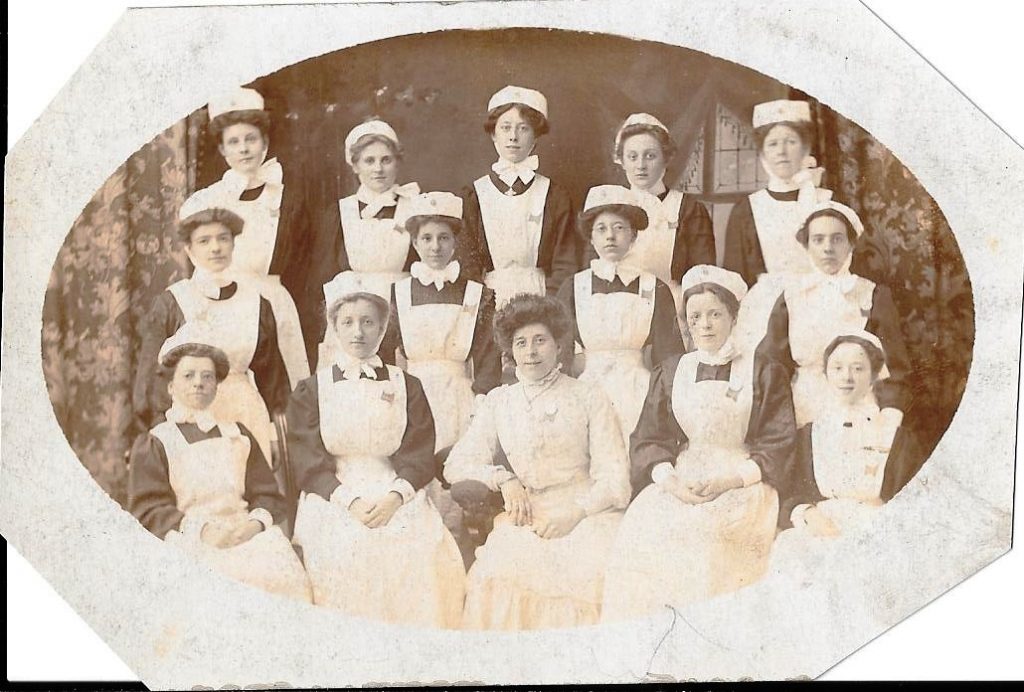
Alfred Back row left identified by being the only smoker!
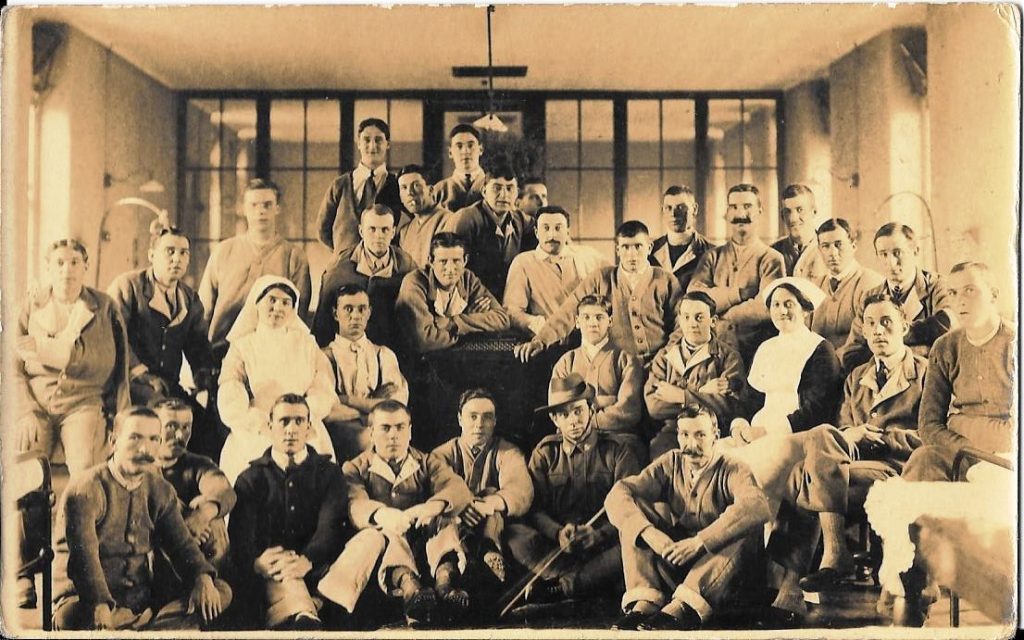
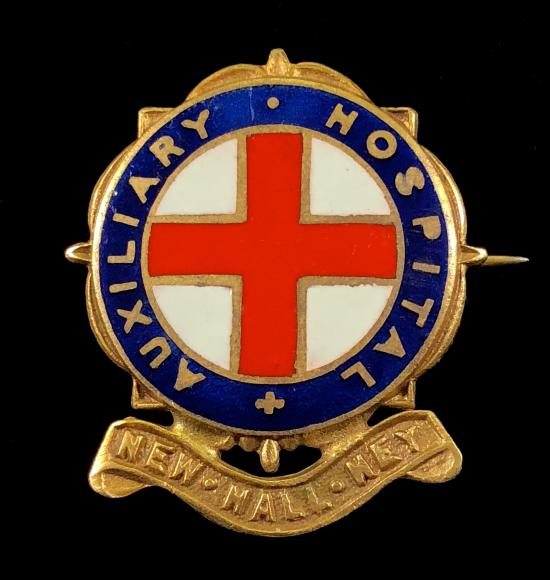
New Hall Hey Badge
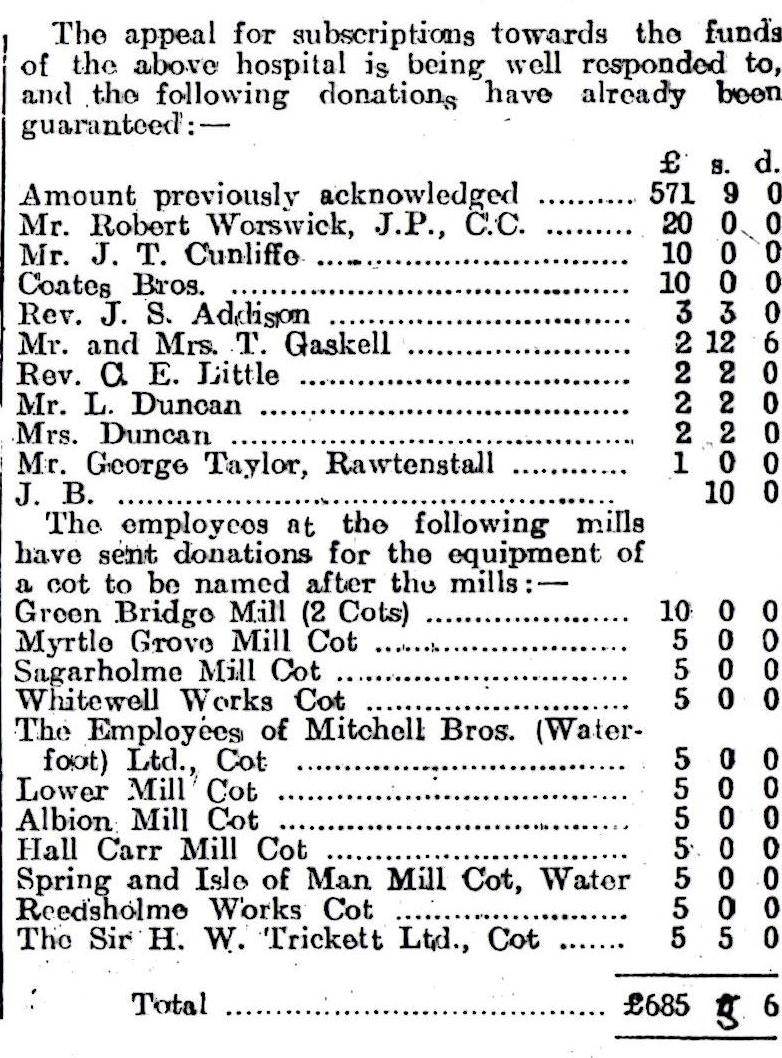

Hi, Can I say Thank You to whoever put this together as it is very interesting. My Grandmother Sarah Willis volunteered to help out at the Hospital where she nursed my Grandfather. My Grandfather was Called Thomas Winter and at the age of 16 enlisted into the Welsh Cavalry where he changed his name to Thomas Winterson and gave his age as 18yrs. He was machine gunned in the legs and ended up at Rawtenstall to convalesce. After the war he came back to find Sarah and the rest as they say is history!
Hi Stanley, thankyou for your kind comments, very ineresting reading about your Grandparents.
Very Best Regards
Dave.
Very much enjoyed reading the history of New Hall Hey House.
I used to pass it each morning on my way to school.
Please could you tell me when it was pulled down.
many thanks
hi Joan, glad you enjoyed the New Hall Hey article, I do not know the exact date it was pulled down but I would expect late sixties/early seventies, when the M66 was built and the ever increasing traffic needed more room and order. its a shame it has all gone now, did it look rundown when you used to pass it?
Best Regards
Dave.
My Grandfather Alfred Whitehouse was sent there,after being gassed,and shot,on the Somme.My
Grandmother was from Rawtenstall,and worked there as a V.A.D,her name was Muriel Willis Fairbourne,from Bank St.
They got married in Rawtenstall,Grandad was from Northampton.
I have three photos taken when he was in there,with quite a few other soldiers,and nurses.
Thanks for your article,it’s very interesting to me to find out so much about the hospital.
Best Regards,Suzanne Katz
Thank you David,for putting up my photos.
I’ll check in from time to time,and if I find anything else,I’ll send it to you.
Best Wishes,Suzanne
Dave I love your writing. It very easy to understand and flows very well. A+ for you,
I’m not sure if you know the hospitals Superintendent Dr Compston is Edmund Leach Compston. He’s Alderman Samuel Compston’s son.
I do know Samuel Compston passed the Compston Cross everyday with his black bag in hand delivering medicine for his son as he hadn’t the time to do so himself.